ISSN ONLINE(2278-8875) PRINT (2320-3765)
ISSN ONLINE(2278-8875) PRINT (2320-3765)
Merugumalla Manoj kumar1, Pasumarthi.Vishnuvardhan2, Pudota.Ignatius Sirisha3
|
| Related article at Pubmed, Scholar Google |
Visit for more related articles at International Journal of Advanced Research in Electrical, Electronics and Instrumentation Engineering
This paper presents the model of a mobile robot that can inspect the conditions in an underground cable tunnel even in dangerous environmental conditions where human presence is harmful. Hence, this robot substitutes the inspection of a human in the underground cable tunnel. The robot does online inspection through the tunnel travelling from one end to other end and all the information about the underground tunnel with respect to temperature, presence of harmful gases, obstacles, fire accidents, failure in supply etc. is transmitted wirelessly to a device on the ground. Hence this knowledge of situation at tunnel sent by the robot enables us to estimate the danger level and accordingly plan the measures to address the problem in a fastest way possible. Though there were several approaches made to enable this online monitoring system, this paper presents the functioning of robot with a GPS tracker which gives the co-ordinates of the fault location and this helps us to locate the exact fault location reducing the time and work to replace the faulty part. This enables zero downtime of supply, interruption free supply.
Keywords |
| GPS tracker, online inspection, robot, underground cable, zero downtime. |
INTRODUCTION |
| Apart from generation, transmission of electrical energy stood as a challenging task due to various constraints since the inception of using electrical energy. It is common to have transmission lines held along the road side being mounted on poles. But the idea of having an underground cable to transmit power is also another alternative. Overhead lines are vulnerable to lightning strikes which can cause service interruption. Overhead lines use bare conductors and can cause damage if they break. They are considered to be unsightly as they mar the scenery of the landscape [1]. The maintenance cost of overhead lines is more and the voltage drop in overhead lines is more Hence, underground cable for power transmission stood as second thought apart from the overhead lines. There are several challenges to be addressed in implementing this technology [6, 2]. To make the tunnel environment safe enough for functioning and maintaining zero downtime of supply we need to check and correct the faults taking place in the underground cable. However, it is a difficult task to locate the fault in underground cable when compared to overhead lines [7]. This mobile inspection robot is one endeavor to check online the condition of tunnel using mobile inspecting robot. This approach gained momentum and there are many experiments being conducted and tested for the online monitoring [8]. |
EXPERIMENTAL DETAILS |
| A. Equipment’s Used |
| 1) Temperature sensor - LM35: The LM35 [4, 3] series are precision integrated-circuit temperature sensors, whose output voltage is linearly proportional to the Celsius (Centigrade) temperature. The LM35 thus has an advantage over linear temperature sensors calibrated in ° Kelvin, as the user is not required to subtract a large constant voltage from its output to obtain convenient Centigrade scaling. |
| 2) IR Sensor: The IR Sensor is a general purpose proximity sensor. Here we use it for collision detection. The module consists of an IR emitterand IR receiver pair as shown if Fig 1. The high precision IR receiver always detects an IR signal. The module consists of a 358 comparator IC. The output of sensor is high whenever it is in IR frequency and low otherwise. The on-board LED indicator helps user to check status of the sensor without using any additional hardware. The power consumption of this module is low. It gives a digital output. |
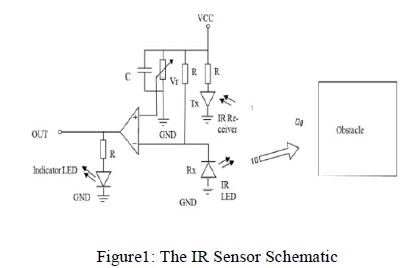 |
| 3) Gas sensor: Semiconductor type combustible gas sensor MQ2 is used to detect the presence of smoke and other harmful gases like methane. It can detect the concentrations in the range 300 – 10000 |
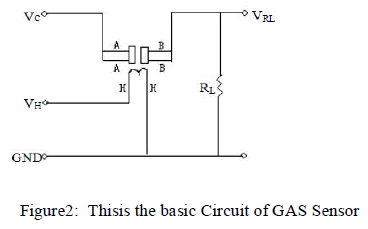 |
| PPM.VH is the heater voltage and VC is the test voltage. VH supplies the working temperature to the sensor, while VC is used to detect voltage on VRL on load resistance. |
| 4) Discharge Sensor: The Fig 3 is the discharge sensor circuit which can detect the invisible fields of voltage which surrounds all electrified objects. It acts as an electronic "electroscope. “Regular foil-leaf electroscopes deal with electrostatic potentials in the range of many hundreds or thousands of volts. Its sensitivity is very high. Since "static electricity" in our environment is actually a matter of high voltage, this device can sense those high-voltage electrically charged objects at a great distance. If a metal object is lifted up upon a non-conductive support and touched against the sensor wire, the sensor can detect whether that object has an electrostatic potential of as little as one volt. |
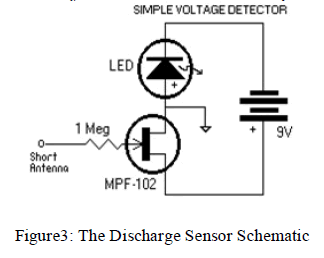 |
| 5)Metal Sensor:Inductive proximity sensors operate under the electrical principle of inductance. To amplify a device’s inductance effect wire is twisted into a tight coil. This inductive proximity Sensor M12PNP has four components; the coil, oscillator, detection circuit and output circuit. The oscillator generates a fluctuating magnetic field the shape of a doughnut around the winding of the coil that is located in the device’s sensing face which is shown in Fig 4. When a metal object moves into the inductive proximity sensor’s field of detection, Eddy circuits build up in the metallic object, magnetically push back, and finally reduce the Inductive sensor’s own oscillation field. The sensor’s detection circuit monitors the oscillator’s strength and triggers an output from the output circuitry when the oscillator becomes reduced to a sufficient level. |
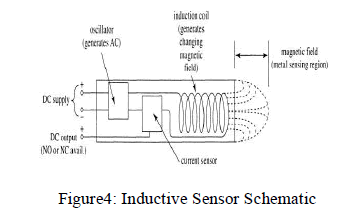 |
| 6) Hall Sensor: The hall voltage produced is due to the creation of electric field by the separation of electric charges in an external magnetic field. That means whenever electric charges on this Hall sensor W49E are in the external magnetic field due to the current flowing through the cable they experience a force and get aligned on either sides creating a magnetic field and hence the hall voltage. |
| V is the hall voltage, I is the current through the hall sensor, B the external perpendicular magnetic field and t the thickness. |
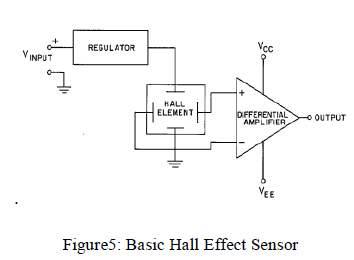 |
| 7) Wireless transceiver (RF CC2500 Wireless module): This High Speed CC2500 Based Wireless module is a plug and play replacement for the wired Serial Port (UART) supporting baud rates up to 38400.Commercially available Remote Control (R/C) units use small microcontrollers in the transmitter and receiver to send, receive and interpret data sent via radio frequency (RF). The receiver box has a PCB (printed circuit board) which comprises the receiving unit and a small servo motor controller. RF communication requires either a transmitter matched/paired with a receiver, or a transceiver (which can both send and receive data). RF does not require line of sight and can also offer significant range (transmission distance). Standard radio frequency devices can transfer data between devices as far away as several kilometers and there is seemingly no limit to the range for more professional RF units [9].The robot used is made semi-autonomous robot with RF capability since it allows the robot to be as autonomous as possible, provide feedback to a user and still give the user some control over some of its functions. Range 60+ meters, Line of Sight 30 meters range indoors. Direct Replacement for wired Serial Cable for and serial communication can be achieved. |
| 8) H-bridge: While controlling the speed of a DC motor with a single transistor has many advantages it also has one main disadvantage, the direction of rotation is always the same, it’s a "Uni-directional" circuit. H-bridge circuit arrangement and this type of circuit will give us "Bi-directional" DC motor control as shown below. |
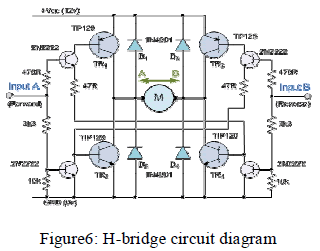 |
| The Transistor or MOSFET H-bridge as shown in Fig 6 is probably one of the most commonly used type of bidirectional DC motor control circuits[5] which uses both NPN and PNP in each branch with the transistors being switched together in pairs to control the motor. Control input Aoperates the motor in one direction i.e., Forward rotation and input B operates the motor in the other direction (Reverse rotation). Then by switching the transistors "ON" or "OFF" in their "diagonal pairs" we can achieve directional control of the motor. |
| For example, when transistor TR1 is "ON" and transistor TR2 is "OFF", point A is connected to the supply voltage (+Vcc) and if transistor TR3 is "OFF" and transistor TR4 is "ON" point B is connected to 0 volts (GND). Then the motor will rotate in one direction. If the switching states are reversed so that TR1 will be "OFF", TR2 will be "ON", TR3 is "ON" and TR4 is "OFF", the motor current will now flow in the opposite direction causing the motor to rotate in the opposite direction. Then, by applying opposite logic levels "1" or "0" to the inputs A and B the motors rotational direction can be controlled as follows. |
| 9) DC motor: 60RPM 12V DC geared motors for robotics applications. It gives a massive torque of 38Kgcm. The motor comes with metal gearbox and off-centered shaft Featuresof the motor are -60RPM 12V DC motors with Metal Gearbox and Metal Gears, 18000 RPM base motor, 6mm diameter shaft with M3 thread hole, Gearbox diameter 37 mm., Shaft length 15mm,180gm weight, 38kgcm torque, No-load current = 800 mA, Load current =up to 7.5 A(Max) |
| 10) Video& Audio (JPEG Color Camera Serial UART Interface): New generation serial port camera module can capture high resolution pictures using the serial port. It is a modular design that outputs JPEG images through UART, and can be easily integrated into existing design. The infrared feature has a built-in sensor to sense the ambient light and will automatically turn on the infrared LED. |
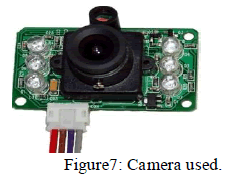 |
| 11) Navigation GPS (Tracking Module): The Fastrax UP501 is a GPS receiver module with embedded antenna and tiny form factor 22.0 x 22.0mm x 8mm. The Fastrax UP501 receiver provides very fast enhanced navigation accuracy by utilizing WAAS/EGNOS corrections, which may be enabled via NMEA command. The Fastrax UP501 module provides complete signal processing from internal antenna to serial data output in NMEA messages. Fastrax UP501D. The Dual-SAW filter is targeted for telematic applications where a radio transmitter is placed close to the GPS receiver. The dual filter design will provide higher attenuation outside of the GPS band and it helps to reduce the risk of EMC issues that are sometimes present when high-gain systems (GPS receiver) that are in strong signal field. National Marine Electronics Association NMEA is a standard protocol, use by GPS receivers to transmit data. NMEA 0183 sentences are all ASCII. |
| 12) Microcontroller: The board is based on the ATmega320.Microcontroller it has 54 digital input/output pins (of which 14 can be used as PWM outputs), 16 analog inputs, 4 UARTs (hardware serial ports), a 16 MHz crystal oscillator, a USB connection, a power jack, an ICSP header, and a reset button. It contains everything needed to support the microcontroller; simply connect it to a computer with a USB cable or power it with an AC-to-DC adapter or battery to get started. |
| 13) Programming: Program is developed to make the data obtained from the controller into the computer to be userfriendly. This program is built on java language and it converts the raw data into graphs, tables, danger indicating marks etc. This helps us to understand the data in a very easy and a fast way. |
B. Construction and Functioning: |
| The First step of this project is constructing a platform to carry all the above discussed sensors integrated into circuits into the tunnel. A 9mm plastic sheet is cut into a hexagonal shaped platform. |
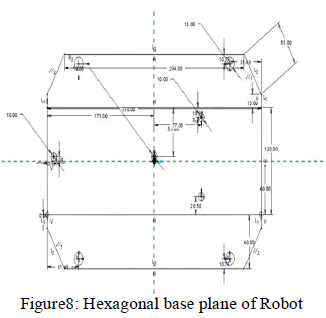 |
| Two 10 RPM motors are fixed at the back end of the platform to drive the robot Chains are installed onto these wheels to enable the even distribution of robot’s weight and to reduce the slip value |
| All the sensors, transceiver, GPS tracker, H-bridge and power supplying battery are connected to the microcontroller according to the pin diagram. Each sensor is tested by a sample program to make sure of its functioning. Then the GPS module is connected to the transmission and receiving pins of the microcontroller and the tracker is tested. The presence of multisensory and additional devices may lead to drain voltage conduction. To protect the micro controller from this, external voltage is supplied besides which an external hardware Arduino Sensor Shield V.5 is used. |
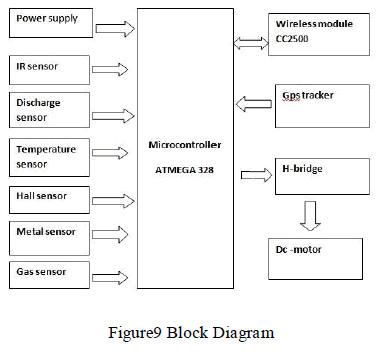 |
| The microcontroller has only two pins for external communication (TX and RX) which are to be accessed by both the GPS tracker and the wireless transceiver. To attend this need the serial port software is used to convert the digital pins (PWM pins) into communication pins (TX, RX) which are connected to transceiver. Now the transceivers are tested. They are programmed for a single channel number and device ID and then loaded. These are run and checked on run mode configuration. |
| All the above circuit elements are integrated into the circuit to their final positions and after testing the whole circuit is placed on the robotic base. Final testing of all the setup is done. The robotic platform is free to move in any of the direction and can move inside the tunnel with ease. This is placed in the virtually created underground cable environment in our college laboratory and the robot is passed through this passage. |
| The information regarding the environment around the robot is transmitted wirelessly to the wireless receiver and transmitter (transceiver) which is connected to a microcontroller. The data is thus transmitted by the transceiver on the robot to the transceiver connected to the microcontroller near the control unit. Microcontroller when interfaces to a computer the data can be seen on the computer screen in the form of graphs and tables. |
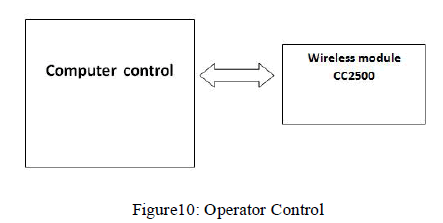 |
| The robot can be controlled from the operator end when the robot cannot make a decision regarding the next step to be taken. It can thus be halted and brought back, when it is not safe for the robot to navigate in the tunnel. The signal from the transceiver near the operator is sent to the transceiver on the robot to control the robot functioning. |
RESULTS |
| The results below are taken when the environment around the cable is safe and when artificially created faults are present their respective results are obtained. |
| The result in Fig 11 is shown when the environment is safe and hence when all the sensors are in off state. |
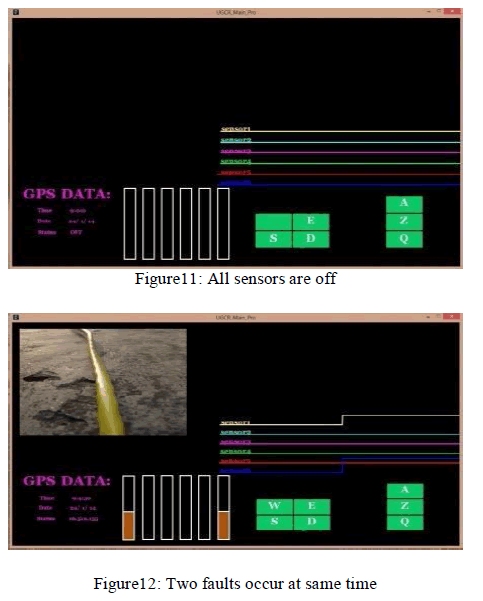 |
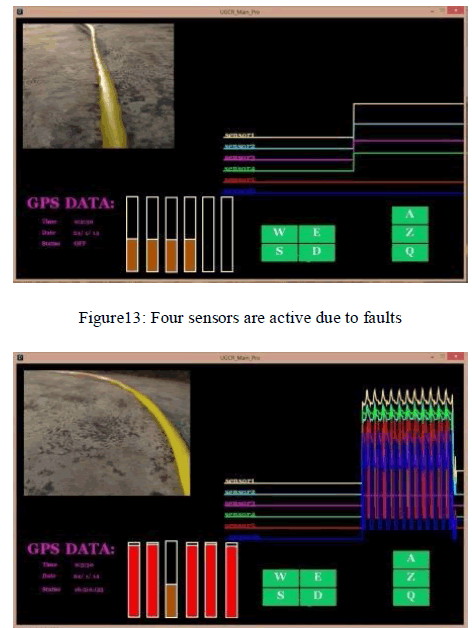 |
| Figure14: Red color on the screen here represents the intensity of the fault and all the faults occur at same time |
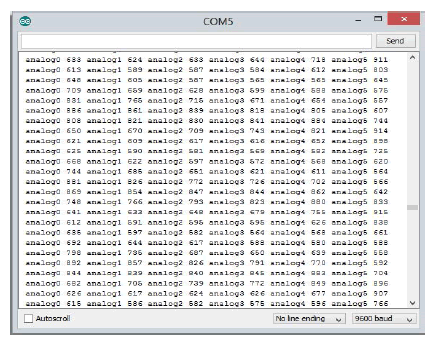 |
| Figure 15: Output taken from the microcontroller before processing the data. This is the actual data from the micro controller which is taken as input to the computer and converted into graphs and pictorial representation for easy understanding using the processing software. |
CONCLUSION |
| The aim of the project is realized by testing the inspection of a mobile robot in a virtual environment conducive in producing real time operating atmosphere of an underground cable which can accurately spot the fault point and can report the co-ordinates of the fault point, which is novel attempt by using a GPS tracker. |
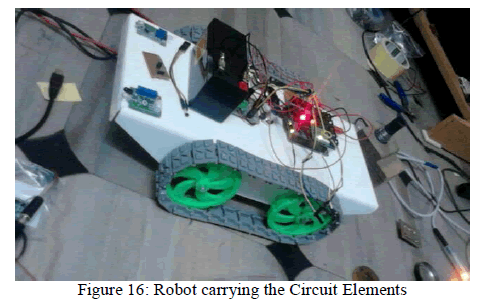 |
References |
|